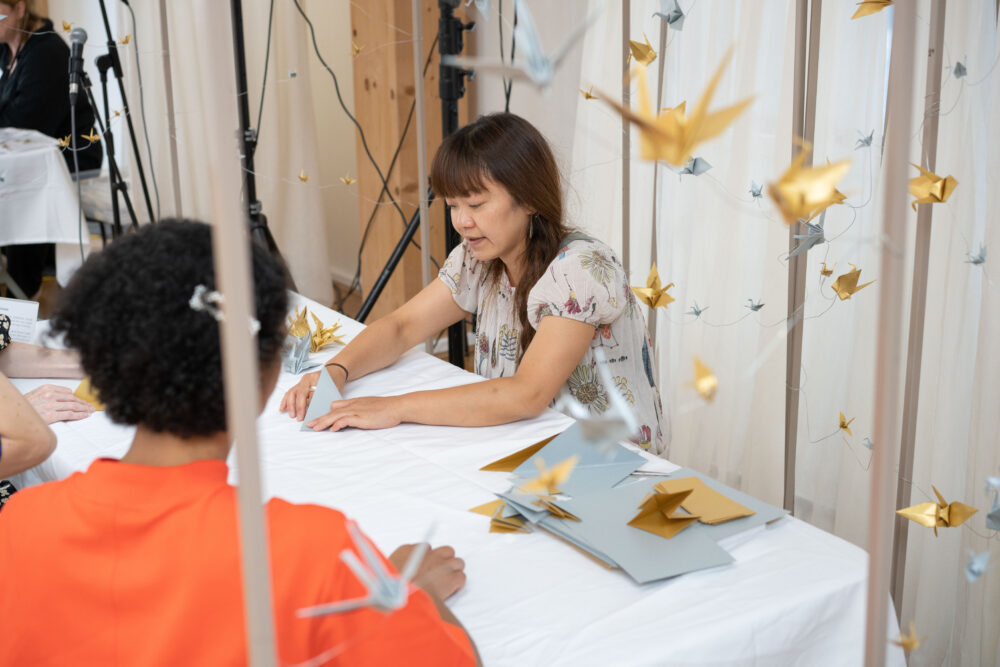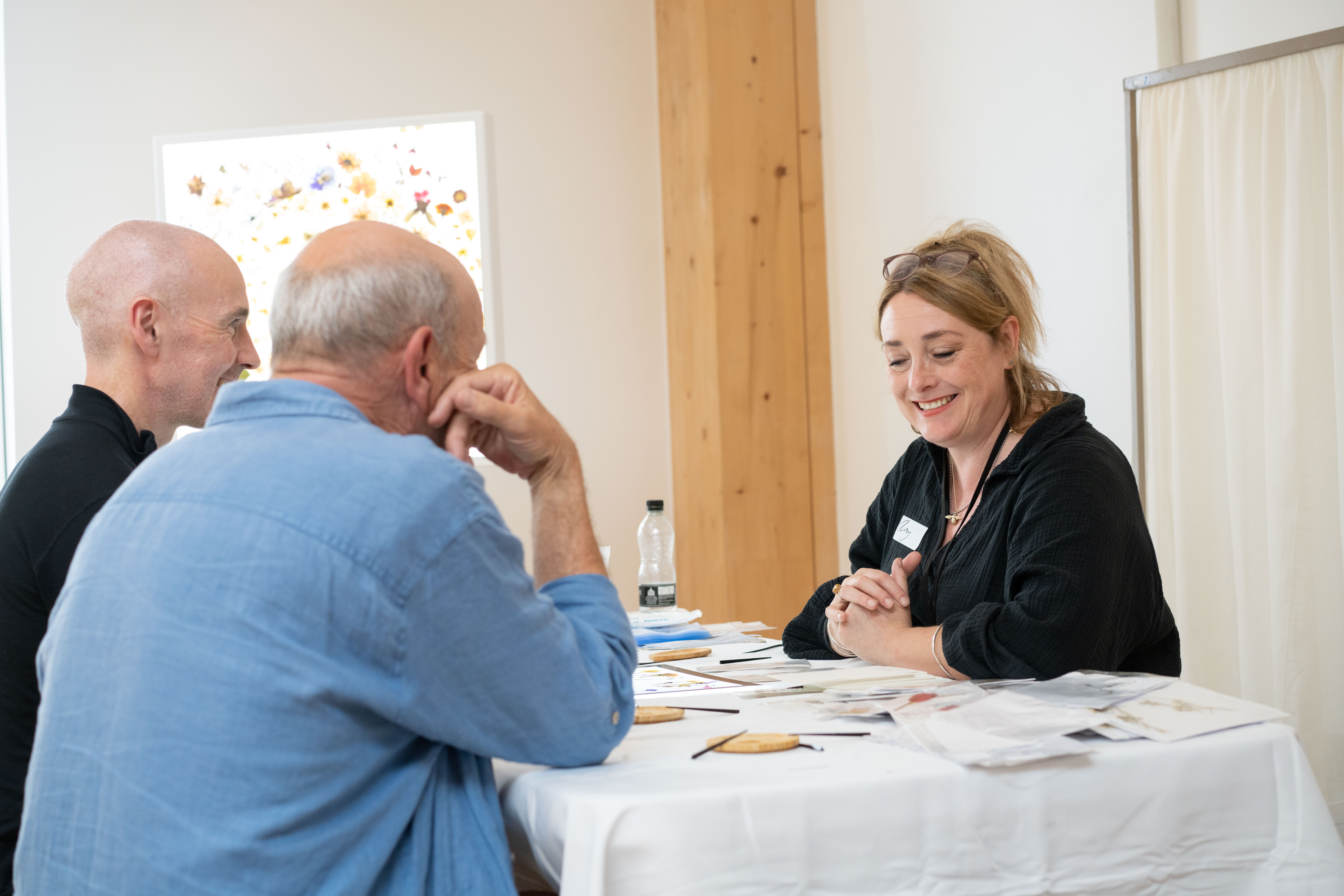
The final step in the research process was to apply the skills, practices and approaches we had learned about in the creative workshops to address the challenges highlighted by the healthcare participants from our interviews.
When the project started, we imagined that our response would take the form of ‘training days’ – educational workshops that last a half or a full day for healthcare professionals. Spending time with our healthcare partners and participants as the pandemic progressed, we realised that this was no longer a suitable approach. Workers in healthcare still face the impact of Covid-19 on a daily basis and are still abiding and limited by Trust rules and regulations. Healthcare staff remain under increased pressure and continue to work from home, which creates difficulty when coordinating teams and finding time to attend training sessions. Therefore, we needed to find a new format for healthcare professionals to reconnect with each other, their patients and their environment.
We decided to pilot a new method of intervention; a programme of activities consisting of in-situ training, workshops, 1-2-1 coaching, film screenings and micro residencies that address the key themes arising from our data. Firstly, all activities aimed to create opportunities for chance and random encounters – something that both healthcare professionals and artists felt was lost throughout the pandemic and deeply missed. With spontaneity key to the creative practice and positive wellbeing, by enabling a spirit of play and improvisation we hoped to provide a space for creativity for healthcare workers that would foster good group dynamics. As enforced rules, social distancing and long days of scheduled Zoom calls have reduced our agency, re-establishing these chance encounters – the conversations around the edges of things – was seen as key to recovery to reduce feelings of isolation and restrictiveness.
Each activity was also created to be light touch and fleet of foot, with staff being given options to sign up or drop in throughout their working day, and flexible enough to allow staff to disappear if they were called away. Our aim was to create activities that were inclusive for all healthcare workers regardless of band, discipline or creative ability, and kept disruption to a minimum to ensure that there was no interruption to patient care. Every activity linked to a specific theme of our research to explore with participants. This way, our Associate Artists became messengers, communicators and connectors, sharing and discussing the findings of our research with staff in a digestible and practical way as they gathered with staff both online and in real life.

Many performance and visual art practices are reliant on touch and on physical contact between people, objects and materials. These techniques were seen as potential ways to reawaken sensory awareness and connection. During our interviews healthcare professionals had described the negative impact of the loss of touch on their work, their wellbeing and on the sense of support between their colleagues; the artists responded with ideas about the importance of re-establishing touch beyond the pandemic, a rediscovery of something that had been altered/lost. In response, performer and choreographer Nandi Bhebhe and artist Phoebe Davies (Bhebhe&Davies), curated a series of artists’ short films that contemplate care, touch, intimacy, and verbal and non-verbal communication. The films use performance on camera (with spoken word and contemporary movement) to open up space to question the meaning of touch and healing within a healthcare context.
Other activities, such as Florilegium by visual artist Amy Shelton, acknowledge the innate human need to connect with the natural world through artistic encounters that focus on bringing the outside inside. Amy’s project invites staff to create a postcard at a temporary flower pressing station to dedicate to a loved one or colleague to show appreciation, or to yourself as a token to your own selfcare. Sharing expertise about the medicinal properties of flowers, Amy’s knowledge also helps staff to look at spaces such as hospital gardens in a new way that aims to broaden their appeal and strengthen staff’s engagement with their environment.

Artist Tim Spooner, who works in performance, drawing, painting, sculpture and design created a drop in session for staff to explore objects within the hospital setting, by creating mini monuments to the hospital. The activity explored how our relationship with objects at work may have changed through necessity – in the abundance of single use plastic – or randomness, and how these objects become ways to communicate non-verbally, intentionally or unintentionally.
Lockdowns and isolation shrank spaces, and rooms were forced to become multipurpose as bedrooms became offices. Some of our activities aimed to address the changed relationships with physical and natural spaces. A guided audio tour, created by theatre maker and artist Silvia Mercuriali aimed to help staff take a break and rediscover the familiar environment of their hospital workplace.
Suzy Willson and Clod Ensemble also designed a session to help staff to navigate the hospital environment by creating a series of micro choreographies. The participating artists described the way they could bring heightened spatial awareness, helping people to map out their working spaces and how they work within them.
Verbal and non-verbal barriers to communication were also addressed through activities, with some focusing more specifically on skill development.
During our interviews we found that staff had been experiencing sore throats more frequently since the pandemic due to the increased use of mask wearing. Another doctor we spoke to had said he had been clenching his jaw tightly in order not to scream at the magnitude of it all and that this was affecting his voice. Through a series of individual and group sessions, Hazel Holder, acclaimed voice coach, actor, singer and theatre maker, helped staff to use their voice more effectively to avoid fatigue and strain and help them feel more grounded and able to communicate with a mask on or off. Hazel also covered breathing techniques, encouraging staff to take mindful breaks for their physical and mental wellbeing.
Feldenkrais Practitioner, martial artist, writer and movement teacher Victoria Worsley designed a session to help staff become more aware of their own movement patterns and habits, and understand how these affect their non-verbal interactions with others around them. Our artists spoke about the value of learning to move freely, to uncover new possibilities and relationships with regulated spaces. By addressing personal challenges or the physical demands of certain job roles, Victoria helped staff to incorporate movement into daily routines to support wellbeing and self-care.
Lastly, a bespoke session led by the Performing Medicine core team explored experiences of respectful communication between both colleagues and patients. This workshop aimed to rebuild support networks and teams that had felt disconnected through the pandemic such as those who work frequently from home, and for teams that communicate with patients predominantly through video and telephone calls, covering how to navigate difficult conversations and deliver the same quality of in-person care remotely.
Across the conversations with artists, healthcare professionals and our partners, there was a sense that the enormity of what happened during the pandemic had not really been given the space to be acknowledged or honoured. As we come out of the pandemic, there seems to be a sense of numbness, a disconnect, an absence. How do we process a global pandemic at an individual level as well as a collective one? What kind of spaces and languages are needed to acknowledge and understand our experiences outside of a medicalised therapy session which many do not want nor feel they need?
Each of our activities aimed to address this, by providing a safe space for staff to reflect on the past few years without the space holding too much weight. By focusing on an activity, staff were given a starting point, a feeling or a theme to reflect on. For example, Sheila Ghelani designed ‘Some Hands to Hold You’ an activity that invites staff to consider their relationship to time. Through a mini ritual that involved breaking individual sealed ampoules, Sheila encouraged staff to look back and identify what they wanted to take forward from the past and carry with them.
Other sessions led by Makiko Aoyama provided an opportunity for staff to take 10 minutes out of their day to create an origami swan. This short activity allowed staff to focus their attention on one simple task enabling them to re-energise, and reflect on the symbolism of the Crane in Japan where strings of origami cranes are often given to people suffering from illness or injury as a way of bringing them back to health. Our activities encouraged staff to be present, and provided ways for them to foster their connections, show gratitude to others, but they also demonstrate the multitude of ways in which staff could take a break and take care of their minds.

Offering opportunities for healthcare workers to engage in artistic practices can play a critical role in creating more compassionate, sustainable healthcare. At a time where staff turnover across the NHS is high and there is a pressure to return to pre-pandemic care with limited resources and little reparation to staff for their services over the past 2 years, we were pleased to hear our partners say that cultural engagement had offered new strategies to empower staff and provide ways to improve their wellbeing, their awareness and their ability to communicate with each other.
Through these creative activities, we were able to design and deliver a programme of cultural engagement that was inclusive and diverse, covering a range of themes and skills that helped support staff. Through quiet reflection and focused work, our programme enabled staff to reconnect with colleagues and their working environments. We demonstrated how fun and creative moments can brighten the working day, and explored the multitude of ways that self-care can be expressed.
Keep up to date with the latest news and updates on ‘Communicating through Covid’ on our Twitter; @PerformingMed1
Image credits: Hugo Glendinning, Clod Ensemble – Performing Medicine, Communicating through Covid.